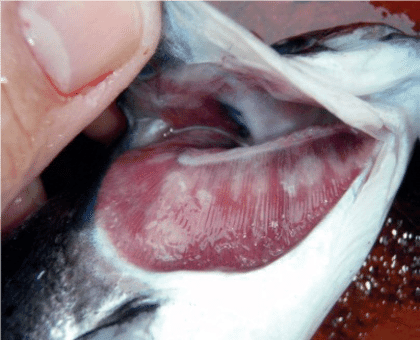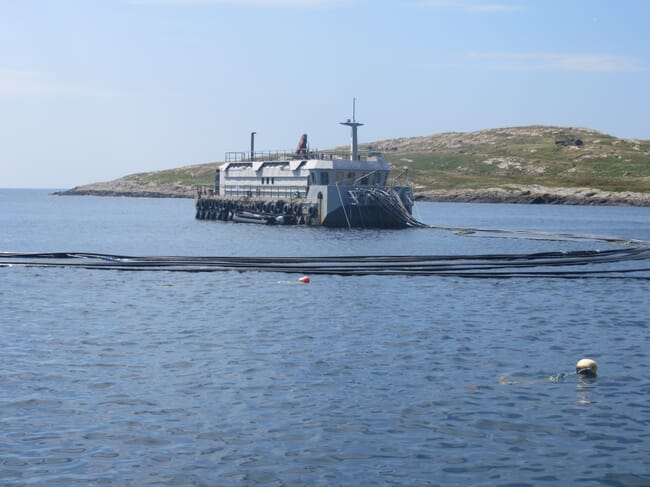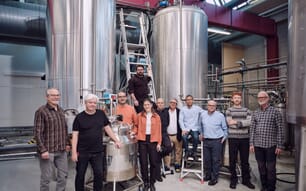Research continues apace for solutions to mitigate the impacts of AGD on farmed salmon populations. It appears that current knowledge transfer to production has reduced the impacts of AGD when compared to the 2011-2013 period. Present research status is as follows:
Genetic selection and breeding programmes
Akvaforsk Genetics, one of several breeding companies in Norway, have been genetically breeding Atlantic salmon for aquaculture since the 1970s, first for their own national market and then for international markets. Disease resistance has been one focus of research, with strains now able to select for improved resistance to infectious salmon anaemia (ISA), infectious pancreatic necrosis (IPN) and furunculosis.

© Mark Adams and Hamish Roger
Recently, there have been large efforts to improve resistance to AGD through genetic selection with programmes in Tasmania and Norway underway. Tests to determine if there is any genetic basis for AGD resistance in Tasmania indicate that there is sufficient genetic variation to consider breeding programmes to select for resistance or tolerance to AGD.
SalmoBreed in Norway currently have two types of roe available for sale called salmobreed and crossbreed, both of which show resistance to AGD as well as to IPN, ILA and PD and lice. Genomically selected roe can be purchased with resistance from up to four different disease strains, depending on the product name: for AGD, salmobreedAGD or crossbreedAGD is selected; for AGD plus IPN resistance, salmobreedDUO or crossbreedDUO should be selected. Anecdotally, Abdon has seen improvements in the resilience of fish on farms in south-west Ireland over the last few years – could this be a result of advances in selective-breeding programmes?
Functional feeds
In 2013, Skretting announced that they were re-testing the provisionally named GT#1 diet for aiding fish that have been infected with AGD. In 2016, Skretting produced a functional feed called Protec gill, claiming that it can modulate key immune-system parameters known to support gill structure and function, helping the fish to maintain osmotic regulation during infection with AGD. These feeds are sold in Norway, Scotland and Chile, but currently there seems little evidence of quantifiable benefits.

Vaccines
There has been considerable research on vaccines for AGD, including the use of recombinant proteins and DNA vaccine approaches, but laboratory-based trials have been affected by co-infection issues. To date, there is little sign of any breakthrough in the research to make a vaccine commercially available.
Cleanerfish
Lumpfish (Cyclopterus lumpus L.) and different wrasse species have been introduced into salmon net-pens as cleaner fish to mitigate the impacts of sea lice, particularly Lepeophtheirus salmonis. The amoeba N. perurans displays low host specificity and both wrasse and lumpfish are susceptible, with lumpfish mortalities in Ireland, Scotland and Norway attributed to AGD.
It is not yet clear to what extent lumpfish or wrasse respond to the challenge, or whether they are a vector for the spread of N. perurans to salmon. Lumpfish tend to be more resistant to the challenge and the parasite’s spread and development is slower than in salmon – therefore utmost care and real-time PCR screening methods should be adopted before lumpfish are put into net-pens to cohabit with salmon, as they may pass AGD on to the salmon.
Another issue is the FW treatment of salmon challenged with AGD when lumpfish or wrasse are cohabiting with salmon, as cleanerfish tolerance to FW may not be sufficient to survive a three- to four-hour bath. Wrasse can be caught with baited pots and removed from the pen before FW treatment can commence.
There are also sustainability and welfare issues: there are not infinite native populations of wrasse in the wild to provide a sufficient supply for current salmon-farm production. Action to address this issue has commenced, with breeding programmes for wrasse and lumpfish where only the broodstock are obtained from the wild, and research into the best strains continues.
Larger smolts
In 2012, MH Technical Services delivered a presentation outlining what might be expected from salmon farming globally by 2020. Three criteria identified were: zero escapes, negligible interaction of sea lice and AGD from farmed to wild fish, and the possibility of retrieving nutrients from marine farms. Responding to these criteria, Marine Harvest are heading an initiative called “optimal post smolt production” (OPP), sponsored by the Research Council of Norway (NRC, 2016) in conjunction with several other industry and research partners, through initiatives like the centre for research-based innovations in aquaculture technology, CREATE.
This initiative aims to produce larger pre-grow-out smolts up to 1kg before they are transferred to SW open net-pens (according to MH Technical Services’ 2012 presentation) with recirculating aquaculture systems and semi-contained/contained systems considered, both with pros and cons.
Larger pre-grow out smolts will decrease grow-out time in SW, which will mitigate lice impacts and pathogenic disease transfer – including AGD – and improve growth rates. Research continues as to whether post-smolts should continue to be grown in land-based RAS operations or in semi-contained systems at sea.
Oxidative stress
When the balance between antioxidant enzymes and reactive oxygen species (ROS) is disrupted, either because of antioxidant depletion or accumulation of ROS, then oxidative stress occurs. This imbalance has recently been noted as one of the mechanisms involved in AGD pathogenesis, either being the cause or consequence of morphological alterations that occur in the gill during AGD.
Dr Mar Marcos-López has undertaken enzymatic studies to study the antioxidant status of salmon gills with analysis of the hydrophilic antioxidant activity (HAA) and activity of the major antioxidant enzymes, superoxide dismutase (SOD), glutathione reductase (GR) and catalase (CAT), before and after the first FW treatment.
A very similar antioxidant capacity in both samples indicated a recovery of the redox system after AGD pathogen elimination, indicating that oxidative stress and impaired antioxidant defences could be a contributory factor in late-stage AGD pathogenesis – although the origin of the stressors could not be determined. Although FW is the current treatment of choice for most AGD outbreaks, H₂O₂ (hydrogen peroxide) was previously used and is still a common treatment for lice infestations. This research by Dr Marcos-López indicates that caution must be observed if treating with H₂O₂ fish that are infected with AGD, as they will be more susceptible to H₂O₂ damage or toxicity. However, antioxidant therapy as a supportive treatment for AGD could be beneficial.
Good husbandry techniques
The three Bs – biomass, biofouling and biosecurity – all need to be taken into account. Salmon farms with net-pens can act as reservoirs for disease. Farm sites with organic status, stocking at a maximum 10kg/m³ may help to reduce spread of amoebae when compared to standard stocking rates.
Clean nets surrounding the cages are a priority and nets must be regularly cleaned and/or changed. Apart from the mechanical disadvantages of fouled nets – such as increased weight putting extra loads on mooring points – they affect fish welfare, reduce oxygen levels, water throughput and waste removal. However, cleaning of nets in situ, especially if heavily fouled, can release large quantities of hydroids and anemones – which possess millions of harpoon-like stinging cells – into the net-pen, potentially comprising the gills of fish.
A safer method from a fish-welfare perspective is to have a programme of regular net changes in which the fouled net is taken ashore for cleaning in purpose-built net drums. Anecdotal evidence from net changing in south-west Ireland saw fouled nets weighing greater than or equal to 16 tonnes (wet weight) being brought ashore when the dry weight was approximately four tonnes, indicating a large amount of fouling.
Improving biosecurity starts at ground level. Personnel – including operatives, managers, divers, vets, wellboat crew, maintenance teams and research students – are all integral to the successful operation of a salmon farm site. Ongoing research to improve biosecurity is important and the transfer of information from this research must be made available to all personnel in a clear and cohesive manner, especially where intra-site movements occur.
Closed containment systems
The adoption of more closed containment systems could help to limit the ingress and/or spread of amoeba. And of all the systems currently being developed, the Hauge egg is possibly the most interesting. It is a new technology that allows for a growing space at sea in a closed system, where the water inlet is approximately 20m below the surface, while the feed enters from the bottom and travels upwards. The potential advantage of this system is that it is an enclosed environment, and as such is fully controllable: lice problems could be eradicated, waste could be collected at the bottom of the system and converted into biofuel and fish escapes should be prevented. It will be interesting to see whether it will mitigate the effects of AGD.
In June 2017, the Norwegian Directorate of Fisheries (NDOF) decided to award Marine Harvest Norway four of the 14 licences that they had applied for to trial these eggs. Marine Harvest responded that this would be inadequate to test industrially and achieves economies of scale, adding that the concept is in danger of not being realised. After an appeal, in December 2017, the NDOF awarded an additional two licences. The price of salmon will most likely need to remain stable for this technology to be trialled successfully and cost-effectively before it is put into production.
Acknowledgements
I would like to thank the following for their kind assistance and information:
Abdon Ryan, husbandry manager, Marine Harvest Ireland; Dr Hamish Rodger, global managing director, Fish Vet Group; Felix Scholz, Fish Vet Group Ireland; and Dr Mar Marcos-López, Fish Vet Group Ireland.


